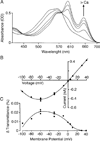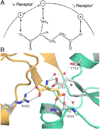The structure and function of glutamate receptors: Mg2+ block to X-ray diffraction
- PMID: 27131921
- PMCID: PMC5075518
- DOI: 10.1016/j.neuropharm.2016.04.039
The structure and function of glutamate receptors: Mg2+ block to X-ray diffraction
Abstract
Experiments on the action of glutamate on mammalian and amphibian nervous systems started back in the 1950s but decades passed before it became widely accepted that glutamate was the major excitatory neurotransmitter in the CNS. The pace of research greatly accelerated in the 1980s when selective ligands that identified glutamate receptor subtypes became widely available, and voltage clamp techniques, coupled with rapid perfusion, began to resolve the unique functional properties of what cloning subsequently revealed to be a large family of receptors with numerous subtypes. More recently the power of X-ray crystallography and cryo-EM has been applied to the study of glutamate receptors, revealing their atomic structures, and the conformational changes that underlie their gating. In this review I summarize the history of this field, viewed through the lens of a career in which I spent 3 decades working on the structure and function of glutamate receptor ion channels. This article is part of the Special Issue entitled 'Ionotropic glutamate receptors'.
Keywords: Glutamate receptors; Structural biology.
Published by Elsevier Ltd.
Figures



Similar articles
-
Structure and gating of the glutamate receptor ion channel.Trends Neurosci. 2004 Jun;27(6):321-8. doi: 10.1016/j.tins.2004.04.005. Trends Neurosci. 2004. PMID: 15165736 Review.
-
Ionotropic glutamate receptor recognition and activation.Adv Protein Chem. 2004;68:313-49. doi: 10.1016/S0065-3233(04)68009-0. Adv Protein Chem. 2004. PMID: 15500865 Review.
-
Glutamate receptor gating.Crit Rev Neurobiol. 2004;16(3):187-224. doi: 10.1615/critrevneurobiol.v16.i3.10. Crit Rev Neurobiol. 2004. PMID: 15701057 Review.
-
Structure and symmetry inform gating principles of ionotropic glutamate receptors.Neuropharmacology. 2017 Jan;112(Pt A):11-15. doi: 10.1016/j.neuropharm.2016.08.034. Epub 2016 Sep 20. Neuropharmacology. 2017. PMID: 27663701 Free PMC article. Review.
-
Emerging structural explanations of ionotropic glutamate receptor function.FASEB J. 2004 Mar;18(3):428-38. doi: 10.1096/fj.03-0873rev. FASEB J. 2004. PMID: 15003989 Review.
Cited by
-
The Discovery and Characterization of Targeted Perikaryal-Specific Brain Lesions With Excitotoxins.Front Neurosci. 2020 Sep 8;14:927. doi: 10.3389/fnins.2020.00927. eCollection 2020. Front Neurosci. 2020. PMID: 33013307 Free PMC article. Review.
-
The Protein Biochemistry of the Postsynaptic Density in Glutamatergic Synapses Mediates Learning in Neural Networks.Biochemistry. 2018 Jul 10;57(27):4005-4009. doi: 10.1021/acs.biochem.8b00496. Epub 2018 Jul 3. Biochemistry. 2018. PMID: 29913061 Free PMC article.
-
Glutamate Supply Reactivates Ovarian Function while Increases Serum Insulin and Triiodothyronine Concentrations in Criollo x Saanen-Alpine Yearlings' Goats during the Anestrous Season.Animals (Basel). 2020 Feb 2;10(2):234. doi: 10.3390/ani10020234. Animals (Basel). 2020. PMID: 32024282 Free PMC article.
References
-
- Armstrong N, Gouaux E. Mechanisms for activation and antagonism of an AMPA-sensitive glutamate receptor: Crystal structures of the GluR2 ligand binding core. Neuron. 2000;28:165–181. - PubMed
-
- Brown DA, Adams PR. Muscarinic suppression of a novel voltage-sensitive K+ current in a vertebrate neurone. Nature. 1980;283:673–676. - PubMed
Publication types
MeSH terms
Substances
Grants and funding
LinkOut - more resources
Full Text Sources
Other Literature Sources

